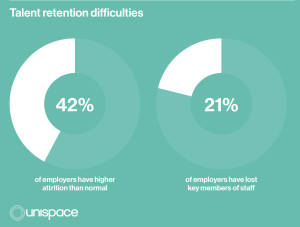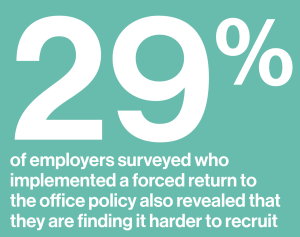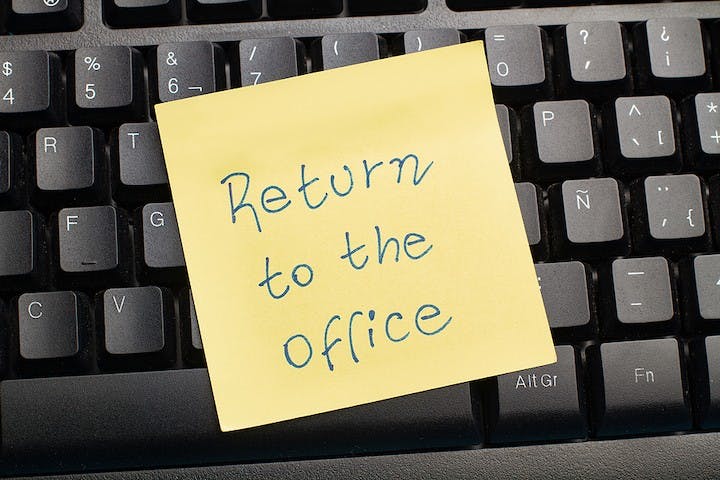Employers – it seems – have finally had enough of the gently-gently approach.
Recent news that Meta’s head of human resources, Lori Goler, sent out a no-nonsense email to staff reminding them of their duty to be in the office at least three days a week (or face the sack), shows that once ever-so-polite requests for employees to consider returning to the office are becoming ever-more directive.
It’s out with the carrot, and in with the stick – and it seems mandated returns very much now the majority.
Meta isn’t the only one to be getting tougher.
In recent months Google, JP Morgan Chase, and law firms including Skadden and Davis Polk & Wardwell have joined a growing list of companies that have now made it abundantly clear to employees that a return-to-office mandate isn’t optional employee policy.
They’ve no doubt all seen recent research suggesting that those who work from home are actually less productive than their office-based peers.
Even online titan, Mark Zuckerberg has gone on record saying ‘in-person work is better’ – an amazing admission for someone keen to build a virtual metaverse.
Why seek a return now?
But perhaps there’s one very good reason why moves to mandate returns are rising at this particular moment in time – and it’s all down to expediency.
It was recently suggested by Brad Bell, William J. Conaty Professor of Human Resource Strategy and CAHRS Academic Director at Cornell’s ILR School, that many HRDs have wanted to do it sooner – but couldn’t.
But now, he argues, with employee resignations now at a three-year low, and employees fearing taking the plunge to move somewhere else, CHROs have sniffed the opportunity they’ve long been waiting for – to strike now, while employee resistance is at its lowest.
But one key question still remains.
Even with a tightening economy, is the mandated approach a gamble CHROs can really afford to take?
And what’s the damage to employee morale, or espoused company values when such a heavy-handed approach is ultimately taken?
Until now, few people have really had a firm answer to this – and the decision to mandate has literally been that – a gamble.
But new data now sheds light on potentially just how damaging this strategy could be – and might even force some to change their mind.
The stick approach gets a beating
A recently published paper by Unispace – ‘Returning for Good’ – suggests the stick approach could have lasting damage on companies talent pipelines.
It found that most employers (72% of them) have mandated that staff return to the office – either full-time, or for a specific minimum number of days.
But the shock finding is that nearly half (42%) of companies it studied (including those in the US), who had used a return-to-office mandate, said they saw higher levels of employee attrition than they had anticipated.
A further 21% also said that they had lost ‘key members of staff’ as a result of a forced return policy (see below):

In other words, despite CHROs guessing there would be some negative impact (something they factored into their decision-making), even they were surprised by the bad feeling it created.
Overall, it also found that 29% of employers who implemented a forced return to the office were now finding it harder to recruit people.

It also found that when staff are forced to come back, they are less happy, less motivated, and less excited about being in the office in the first place.
Does it have to be this way?
The big irony about all this however, is that there is another key message of the research – which is that employees do actually want to be in the office.
So hold, on, what’s all this about?
Yes, contradictory as it may sound, the research actually finds the office is a big pull for people.
The ability to socialize (33%); the opportunity to collaborate (28%) and having better IT/facilities (21%), are all factors that swing things in favor of being in an office.
All-told, 79% of those aged 18-34 expect to be in the office for a minimum of four days a week (it is 67% amongst those aged 35-44 and 51% for those over 45).
So the big turnoff – it seems – really is just the enforced element of it.
Tell staff to come back and they’ll react, but don’t force it on them, and the inference is they’ll gravitate there anyway.
But how can HRDs be sure staff will voluntarily return?
There are ways for CHROs to wave a carrot, it seems.
Overall 72% of staff said they would be happy to return to the office for more training and development, while in America specifically, 86% of those polled said they would be more inclined to return to the office if they had a designated desk, rather than be required to hot-desk.

So…worried about getting staff to come back? It sounds simple, but you just have to give them a ‘reason’ to return. Just like chastising a child, telling them (even yelling at them) won’t really work.
Come back to the office – now!
- At Apple senior leaders told workers to return to work at least three days a week. CEO Tim Cook had said that the decision was meant to restore “in-person collaboration.”
- Disney CEO, Bob Iger, told employees they needed to spend at least four days a week in the office.
- Salesforce CEO, Marc Benioff, said recently joined employees should spend some time in the office.
- JP Morgan CEO Jamie Dimon told half of its employees to return to the office five days a week and another 40% to go in a few days a week.
